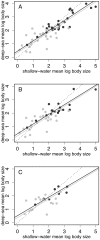The "island rule" and deep-sea gastropods: re-examining the evidence
- PMID: 20098740
- PMCID: PMC2808249
- DOI: 10.1371/journal.pone.0008776
The "island rule" and deep-sea gastropods: re-examining the evidence
Abstract
Background: One of the most intriguing patterns in mammalian biogeography is the "island rule", which states that colonising species have a tendency to converge in body size, with larger species evolving decreased sizes and smaller species increased sizes. It has recently been suggested that an analogous pattern holds for the colonisation of the deep-sea benthos by marine Gastropoda. In particular, a pioneering study showed that gastropods from the Western Atlantic showed the same graded trend from dwarfism to gigantism that is evident in island endemic mammals. However, subsequent to the publication of the gastropod study, the standard tests of the island rule have been shown to yield false positives at a very high rate, leaving the result open to doubt.
Methodology/principal findings: The evolution of gastropod body size in the deep sea is reexamined. Using an extended and updated data set, and improved statistical methods, it is shown that some results of the previous study may have been artifactual, but that its central conclusion is robust. It is further shown that the effect is not restricted to a single gastropod clade, that its strength increases markedly with depth, but that it applies even in the mesopelagic zone.
Conclusions/significance: The replication of the island rule in a distant taxonomic group and a partially analogous ecological situation could help to uncover the causes of the patterns observed--which are currently much disputed. The gastropod pattern is evident at intermediate depths, and so cannot be attributed to the unique features of abyssal ecology.
Conflict of interest statement
Figures


Similar articles
-
Hydroids (Cnidaria, Hydrozoa) from Mauritanian Coral Mounds.Zootaxa. 2020 Nov 16;4878(3):zootaxa.4878.3.2. doi: 10.11646/zootaxa.4878.3.2. Zootaxa. 2020. PMID: 33311142
-
A source-sink hypothesis for abyssal biodiversity.Am Nat. 2005 Feb;165(2):163-78. doi: 10.1086/427226. Epub 2004 Dec 22. Am Nat. 2005. PMID: 15729648
-
Incorporation of deep-sea and small-sized species provides new insights into gastropods phylogeny.Mol Phylogenet Evol. 2019 Jun;135:136-147. doi: 10.1016/j.ympev.2019.03.003. Epub 2019 Mar 7. Mol Phylogenet Evol. 2019. PMID: 30853382
-
How we study cryptic species and their biological implications: A case study from marine shelled gastropods.Ecol Evol. 2023 Sep 5;13(9):e10360. doi: 10.1002/ece3.10360. eCollection 2023 Sep. Ecol Evol. 2023. PMID: 37680961 Free PMC article. Review.
-
Pleurotomarioidean gastropods.Adv Mar Biol. 2002;42:237-94. doi: 10.1016/s0065-2881(02)42015-9. Adv Mar Biol. 2002. PMID: 12094724 Review.
Cited by
-
Peruvian nudibranchs (Mollusca, Gastropoda, Heterobranchia): an updated literature review-based list of species.Zookeys. 2023 Aug 23;1176:117-163. doi: 10.3897/zookeys.1176.103167. eCollection 2023. Zookeys. 2023. PMID: 37664867 Free PMC article. Review.
-
Convergent evolution of reduced energy demands in extremophile fish.PLoS One. 2017 Oct 27;12(10):e0186935. doi: 10.1371/journal.pone.0186935. eCollection 2017. PLoS One. 2017. PMID: 29077740 Free PMC article.
-
Long-Distance Travellers: Phylogeography of a Generalist Parasite, Pholeter gastrophilus, from Cetaceans.PLoS One. 2017 Jan 13;12(1):e0170184. doi: 10.1371/journal.pone.0170184. eCollection 2017. PLoS One. 2017. PMID: 28085945 Free PMC article.
-
Enlarged Egg Size Increases Offspring Fitness of a Frog Species on the Zhoushan Archipelago of China.Sci Rep. 2019 Aug 12;9(1):11653. doi: 10.1038/s41598-019-48147-8. Sci Rep. 2019. PMID: 31406161 Free PMC article.
References
-
- Foster JB. Evolution of mammals on islands. Nature. 1964;202:234–235.
-
- Van Valen L. Pattern and balance in nature. Evolutionary Theory. 1973;1:31–49.
-
- Lomolino MV. Body size of mammals on islands: the island rule re-examined. Am Nat. 1985;125:310–316.
-
- Lomolino MV. Body size evolution in insular vertebrates: generality of the island rule. J Biogeog. 2005;32:1683–1699.
-
- MacArthur RH, Wilson EO. An equilibrium theory of insular zoogeography. Evolution. 1963;17:373–387. (doi: 10.2307/2407089) - DOI
Publication types
MeSH terms
LinkOut - more resources
Full Text Sources

